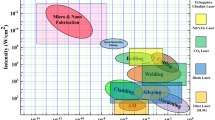Abstract
In selective laser melting machines, continuous laser are usually used to melt the powder. The support structures, which are inevitable when dealing with elaborated pieces, necessitate a complex design by CAD in order to be easily removed. This paper propose an innovative laser manufacturing method by combining pulsed and continuous modes of radiation. Continuous radiations are used for the object-to-build itself, in order to guarantee the requested mechanical properties. Pulsed radiations are used to build the support structures. The resulting support structures have sufficient mechanical properties to withstand the deposition system and to evacuate heat, and are easy to remove from the denser parts. This building method reduces drastically time to market since the same laser can be used in two modes and because pulsed radiation allows very high scanning speed with high power during the building of support structures.
Similar content being viewed by others
References
Chua CK, Liu A, Leong KF (2008) State of the art in rapid metal manufacturing. In: 3rd international conference on rapid prototyping and manufacturing and 2nd international conference for bio-manufacturing
Levy GN, Schindel R, Kruth JP (2003) Rapid manufacturing and rapid tooling with layer manufacturing (lm) technologies, state of the art and future perspectives. CIRP Ann Manuf Technol 52(2):589–609
Huang X, Ye C, Wu S, Guo K, Mo J (2009) Sloping wall structure support generation for fused deposition modeling. Int J Adv Manuf Technol 42:1074–1081
Liu F-H, Liao Y-S (2010) Fabrication of inner complex ceramic parts by selective laser gelling. J Eur Ceram Soc 30(16):3283–3289
Nee AYC, Fuh JYH, Miyazawa T (2001) On the improvement of the stereolithography (sl) process. J Mater Process Technol 113(1–3):262–268
Vandenbroucke B, Kruth J-P (2007) Selective laser melting of biocompatible metals for rapid manufacturing of medical parts. Rapid Prototyping J 13(4):196–203
Zhou W, Li D, Wang H (2010) A novel aqueous ceramic suspension for ceramic stereolithography. Rapid Prototyping J 16(1):29–35
Kruth JP, Mercelis P, Van Vaerenbergh J, Craeghs T (2008) Feedback control of Selective Laser Melting.In: Bartolo et al (eds) Virtual and rapid manufacturing, pp 521–527
Zaeh M, Branner G (2010) Investigations on residual stresses and deformations in selective laser melting. Prod Eng 4(1):35–45
Gebhardt A, Schmidt F-M, Hotter J-S, Sokalla W, Sokalla P (2010) Additive manufacturing by selective lasermelting the realizer desktop machine and its application for the dental industry. Physics Procedia 5(part 2):543–549
Wong M, Owen I, Sutcliffe CJ, Puri A (2009) Convective heat transfer and pressure losses across novel heat sinks fabricated by selective laser melting. Int J Heat Mass Transfer 52(1–2):281–288
André C (2007) Modélisation quantitative du procédé de frittage sélectif par laser: relation paramètres/microstructure. Ph.D. thesis, EPFL, p 3716
Jhabvala J (2010) Study of the consolidation process under macro- and microscopic thermal effects in selective laser sintering and selective laser melting. Ph.D. thesis, EPFL, p 4609
Kruth J-P, Levy G, Klocke F, Childs THC (2007) Consolidation phenomena in laser and powder-bed based layered manufacturing. CIRP Ann Manuf Technol 56(2):730–759
Fischer P, Leber H, Romano V, Weber HP, Karapatis N, André C, Glardon R (2003) Microstructure of near infrared pulsed laser sintered Titanium samples. Appl Phys A 78:1219–1227
German RM (1996) Sintering theory and practice. Wiley, New York
Klocke F, Wagner C (2003) Coalescence behaviour of two metallic particles as base mechanism of selective laser sintering. CIRP Ann Manuf Technol 52(1):177–180
Tolochko NK, Mozzharov SE, Yadroitsev IA, Laoui T, Froyen L, Titov VI, Ignatiev MB (2004) Balling processes during selective laser treatment of powders. Rapid Prototyping J 10(2):78–87
Fischer P, Romano V, Weber HP, Karapatis NP, Boillat E, Glardon R (2003) Sintering of commercially pure Titanium powder with a Nd:YAG laser source. Acta Mater 51(6):1651–1662
Author information
Authors and Affiliations
Corresponding author
Rights and permissions
About this article
Cite this article
Jhabvala, J., Boillat, E., André, C. et al. An innovative method to build support structures with a pulsed laser in the selective laser melting process. Int J Adv Manuf Technol 59, 137–142 (2012). https://doi.org/10.1007/s00170-011-3470-8
Received:
Accepted:
Published:
Issue Date:
DOI: https://doi.org/10.1007/s00170-011-3470-8




